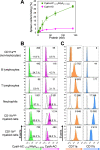Retargeting from the CR3 to the LFA-1 receptor uncovers the adenylyl cyclase enzyme-translocating segment of Bordetella adenylate cyclase toxin
- PMID: 32393579
- PMCID: PMC7363143
- DOI: 10.1074/jbc.RA120.013630
Retargeting from the CR3 to the LFA-1 receptor uncovers the adenylyl cyclase enzyme-translocating segment of Bordetella adenylate cyclase toxin
Abstract
The Bordetella adenylate cyclase toxin-hemolysin (CyaA) and the α-hemolysin (HlyA) of Escherichia coli belong to the family of cytolytic pore-forming Repeats in ToXin (RTX) cytotoxins. HlyA preferentially binds the αLβ2 integrin LFA-1 (CD11a/CD18) of leukocytes and can promiscuously bind and also permeabilize many other cells. CyaA bears an N-terminal adenylyl cyclase (AC) domain linked to a pore-forming RTX cytolysin (Hly) moiety, binds the complement receptor 3 (CR3, αMβ2, CD11b/CD18, or Mac-1) of myeloid phagocytes, penetrates their plasma membrane, and delivers the AC enzyme into the cytosol. We constructed a set of CyaA/HlyA chimeras and show that the CyaC-acylated segment and the CR3-binding RTX domain of CyaA can be functionally replaced by the HlyC-acylated segment and the much shorter RTX domain of HlyA. Instead of binding CR3, a CyaA1-710/HlyA411-1024 chimera bound the LFA-1 receptor and effectively delivered AC into Jurkat T cells. At high chimera concentrations (25 nm), the interaction with LFA-1 was not required for CyaA1-710/HlyA411-1024 binding to CHO cells. However, interaction with the LFA-1 receptor strongly enhanced the specific capacity of the bound CyaA1-710/HlyA411-1024 chimera to penetrate cells and deliver the AC enzyme into their cytosol. Hence, interaction of the acylated segment and/or the RTX domain of HlyA with LFA-1 promoted a productive membrane interaction of the chimera. These results help delimit residues 400-710 of CyaA as an "AC translocon" sufficient for translocation of the AC polypeptide across the plasma membrane of target cells.
Keywords: AC domain translocation; AC translocon; Bordetella pertussis; CyaA; Escherichia coli (E. coli); HlyA; RTX toxin; acylation; acyltransferase; bacterial toxin; complement receptor 3 (CR3,); fatty acid; fatty acyl; integrin; protein acylation; protein translocation.
© 2020 Masin et al.
Conflict of interest statement
Conflict of interest—The authors declare no conflicts of interest in regards to this manuscript.
Figures







References
-
- Linhartová I., Bumba L., Mašín J., Basler M., Osička R., Kamanova J., Prochazkova K., Adkins I., Hejnová-Holubová J., Sadilková L., Morová J., and Sebo P. (2010) RTX proteins: a highly diverse family secreted by a common mechanism. FEMS Microbiol. Rev. 34, 1076–1112 10.1111/j.1574-6976.2010.00231.x - DOI - PMC - PubMed
-
- Gordon V. M., Leppla S. H., and Hewlett E. L. (1988) Inhibitors of receptor-mediated endocytosis block the entry of Bacillus anthracis adenylate cyclase toxin but not that of Bordetella pertussis adenylate cyclase toxin. Infect. Immun. 56, 1066–1069 10.1128/IAI.56.5.1066-1069.1988 - DOI - PMC - PubMed
Publication types
MeSH terms
Substances
LinkOut - more resources
Full Text Sources
Research Materials

